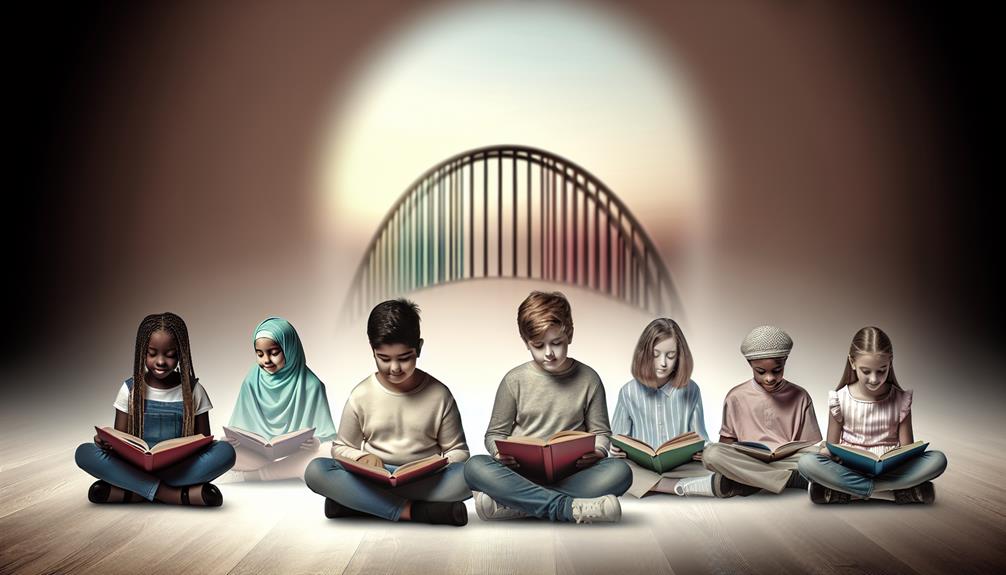In foster care, you'll face challenges like tackling misconceptions, maneuvering adoption complexities, handling emotional trauma, and dealing with inadequate support. Education inconsistency for foster kids is another hurdle. Forearmed with knowledge, these issues can be addressed. Emotional healing strategies, enhancing support networks, stable environments, and personalized tutoring are a few solutions. Were you aware that tailored instruction can help children overcome learning difficulties and that policy reforms can further enhance the welfare of every foster child? Stick around, there's so much more you can uncover about overcoming these hurdles effectively.
Key Takeaways
- Foster care faces challenges like stigmas, adoption complexities, emotional trauma, inadequate support, and educational hurdles.
- Identifying and addressing emotional trauma through therapy, counseling, and building trust is a key solution in foster care.
- Enhancing support networks, providing peer support, and financial assistance can address the challenge of inadequate support in foster care.
- For educational challenges, consistent schooling, personalized tutoring, online learning tools, and tailored instruction can offer significant help.
- Implementing foster care reforms requires policy evaluation, sufficient funding, ongoing training, and accountability mechanisms to ensure the well-being of every foster child.
Identifying Foster Care Problems

Traversing the maze of foster care problems can be overwhelming, but understanding these challenges is the first step toward formulating effective solutions. As you explore this labyrinth, you'll encounter two pertinent issues: Foster Care Stigmas and Adoption Complexities.
The stigma surrounding foster care looms large, often leading to misconceptions and prejudices. You're likely aware of the stereotypical view of foster children as 'damaged' or 'difficult', and foster parents as only in it for the money. This can deter potential foster families, compounding the issue of a lack of stable homes for these children.
Then, there are the complexities of adoption. Moving through the legalities and bureaucracy can be a challenging task. You might feel like you're stuck in a never-ending cycle of paperwork, hearings, and waiting periods. But don't be disheartened. It's a process that demands patience and perseverance.
Challenge One: Emotional Trauma
While handling stigmas and managing adoption complexities are formidable tasks, the emotional trauma experienced by foster children presents an even more profound challenge. The effects of this trauma can linger long after the child has left the foster care system, making emotional regulation a critical concern for the child's overall well-being.
Often, children in foster care have experienced abuse, neglect, and instability, all of which can contribute to emotional trauma. This trauma can manifest in various ways, from behavioral problems to difficulties forming healthy relationships. It can also impact a child's ability to focus, learn, and succeed in school.
Trauma healing, thus, becomes a paramount objective in managing this challenge. However, this is easier said than done. The complex nature of emotional trauma means that a one-size-fits-all approach is rarely effective. It requires a nuanced understanding of the child's experiences and a personalized approach to their healing process.
The role of foster parents, social workers, and therapists is vital in this aspect. They must be skilled in helping the child navigate their trauma, provide a safe and nurturing environment, and assist them in developing emotional regulation skills. This challenge underscores the urgent need for better resources and training in foster care.
Solution for Emotional Trauma

Addressing emotional trauma in foster care involves a multi-faceted approach.
You'll need to first identify the signs of such trauma, which can often be subtle or misunderstood.
From there, you can explore various therapy and counseling techniques, and work on building trust and resilience in the child, which are crucial components of their healing process.
Identifying Emotional Trauma
Understanding the intricacies of emotional trauma in foster children can be a challenging task, but grasping its signs is the first essential step towards providing effective therapy and support. You must be observant, as trauma triggers can vary greatly – a song, a smell, or even a place can bring back painful memories.
Similarly, healing strategies aren't universal, and what works for one child may not work for another. It's key to create a safe space where children feel they can express their emotions freely. By recognizing the signs of emotional trauma early, you'll be better equipped to guide the child through the healing process.
Therapy and Counseling Techniques
Exploring the wide array of therapy and counseling techniques can feel overwhelming, but when you discover the right method for a child dealing with emotional trauma, it's like opening a door to their healing process. Therapeutic Play is one such method. It employs games, art, and other creative outlets to help children express their feelings and confront traumatic experiences. This technique isn't just a game; it's a structured, professional approach that requires expertise.
Counseling Ethics are crucial in this journey. Respecting children's rights, maintaining confidentiality, and promoting their welfare are paramount. You must establish an ethical framework that protects the child's well-being while fostering trust, which is essential for their healing. Remember, your ethical conduct can have a significant impact on the therapy's outcome.
Building Trust and Resilience
In the challenging journey of foster care, one of the most significant steps you can take is to build a foundation of trust and resilience in children who've experienced emotional trauma.
Resilience building is a process that requires time and patience. It's about empowering these children, teaching them coping strategies, and helping them understand their self-worth.
Trust development, on the other hand, is about fostering a safe environment where they feel loved and secure. Remember, trust isn't built overnight. It's a product of consistent, positive interactions. Encourage open communication, show genuine interest in their feelings, and respect their boundaries.
As you navigate this path, remember that every small step towards trust and resilience can make a huge difference in a child's life.
Challenge Two: Inadequate Support

Amid the web of foster care complexities, you may find that insufficient support presents a significant hurdle for both foster children and their caretakers. This challenge, often underestimated, can manifest in two principal areas: the lack of vital support networks and inadequate financial assistance.
Support networks are essential for the well-being of foster families. They provide emotional backing, practical advice, and a sense of community. You might be faced with situations that are unique to foster care, leaving you feeling isolated and overwhelmed. Without a reliable network, these feelings can intensify, making it even more challenging to provide the care that these children desperately need.
Financial constraints, too, can complicate the foster care journey. The cost of fostering a child often exceeds the stipend provided by the state, leading to undue stress. Foster parents may struggle to meet the basic needs of the children, and this financial pressure may deter potential foster parents from entering the system.
Inadequate support, therefore, forms a substantial barrier to effective foster care. It's essential to acknowledge and address this issue, to safeguard the welfare of both foster children and their families.
Solution for Inadequate Support
To address the issue of inadequate support, it is vital to focus on enhancing support networks and financial assistance for foster families. You must recognize that these families often find themselves isolated and financially strained.
Peer support plays a pivotal role in this situation. It involves creating a community of foster families who can share experiences, provide emotional support, and offer practical advice. This shared understanding can be empowering and can help combat feelings of isolation.
Financial assistance is equally important. Foster families often bear the brunt of extra expenses, from therapy fees to transportation costs. Increased financial support can alleviate these burdens, making it more feasible for families to provide a nurturing environment.
Let's put this into perspective.
| Solution | Impact |
|---|---|
| Peer Support | Reduces feelings of isolation, provides emotional support, and allows sharing of practical advice. |
| Financial Assistance | Alleviates financial burdens, makes it more feasible for families to provide a nurturing environment. |
Challenge Three: Educational Gaps

Understanding the educational system can be a challenging task for foster children, often leading to significant educational gaps. The instability of their living situation can disrupt their schooling and make school integration an intimidating task. You may observe that these children frequently change schools, which can lead to inconsistency in their education. It's not uncommon for them to miss out on key components of the curriculum due to these changes.
These gaps can widen when foster children struggle with engaging in extracurricular activities. These activities typically help in developing social skills and a sense of belonging. However, foster children often feel excluded or struggle to participate fully because of their unique circumstances.
Moreover, the trauma and emotional upheaval associated with being in foster care can further impact their academic performance. They might face difficulties in concentration, resulting in lower grades and educational achievement.
In essence, educational gaps form a significant challenge in foster care. It's a multifaceted issue that goes beyond just academic difficulties. It's about school integration, participation in extracurricular activities, and the emotional turmoil that these kids often grapple with. Understanding this is an important step towards finding effective solutions.
Solution for Educational Gaps
Bridging the educational gaps in foster children's lives requires a vital approach that includes stable home environments, consistent schooling, and emotional support. It's not enough to simply place these children in a learning environment; they often need additional help to catch up and keep pace with their peers.
One vital strategy is personalized tutoring. This can provide tailored instruction that meets each child's unique needs, helping them to overcome learning difficulties. A skilled tutor can help foster children grasp difficult concepts and improve their academic performance.
Incorporating technological resources is another effective solution. Online learning tools offer interactive and engaging content that can motivate foster children to learn. In addition, these resources allow children to learn at their own pace, which can be incredibly beneficial for those struggling academically.
Implementing Foster Care Reforms

In the domain of foster care, implementing reforms isn't just about creating new policies; it's about actively shaping a system that truly nurtures the well-being and potential of every child within it. It's about guaranteeing a future where every child has a safe, stable, and nurturing environment to grow and thrive in.
To navigate these reforms, there are certain key aspects you need to focus on:
- *Policy Evaluation*: This is the backbone of any reform. You need to scrutinize existing policies, identify what works and what doesn't, and strategize new approaches based on these insights.
- *Reform Financing*: You need to secure sufficient funding to support these changes. This requires not just fundraising but also efficient allocation of resources.
- *Training and Support*: Foster parents and professionals need ongoing training and support to adapt to new policies and practices.
- *Accountability and Transparency*: There should be mechanisms for accountability and transparency in the system to guarantee that the reforms are implemented effectively.
Frequently Asked Questions
What Is the Process to Become a Certified Foster Parent?
You'll first need to meet specific training requirements. Then, you'll undergo a thorough home study. Joining support groups can be beneficial as they provide valuable advice and resources throughout your certification process.
How Long Does a Child Typically Stay in Foster Care?
You're curious about the typical duration of a child's stay in foster care. Foster Care Statistics show it's around two years. This can have an emotional impact on the child, creating significant challenges.
What Financial Assistance Is Available for Foster Parents?
You're eligible for financial assistance as a foster parent. Support networks offer monthly stipends, and tax benefits exist for child-related expenses. It's crucial to check local regulations for precise information on available resources.
Can Foster Parents Adopt the Children They Are Fostering?
Yes, you can adopt the children you're fostering. However, be aware of attachment issues and prepare emotionally. It's a journey, but with love, patience, and the right support, it can become a beautiful reality.
What Are the Legal Rights of Biological Parents After Their Child Has Been Placed in Foster Care?
You've rights even after your child's placed in foster care. Parental reunification is often the goal, unless termination proceedings are initiated. You can work towards improving your circumstances for your child's return.
Conclusion
Sailing through foster care is like navigating through stormy seas – challenging yet not impossible. With over 400,000 children in the U.S foster system, the hurdles are real: emotional trauma, lack of support, and educational gaps.
But every storm has a lighthouse. By offering emotional healing, robust support, and educational inclusivity, we can guide these children to safe harbors. The journey won't be easy, but with compassion and reform, we can weather the storm together.




